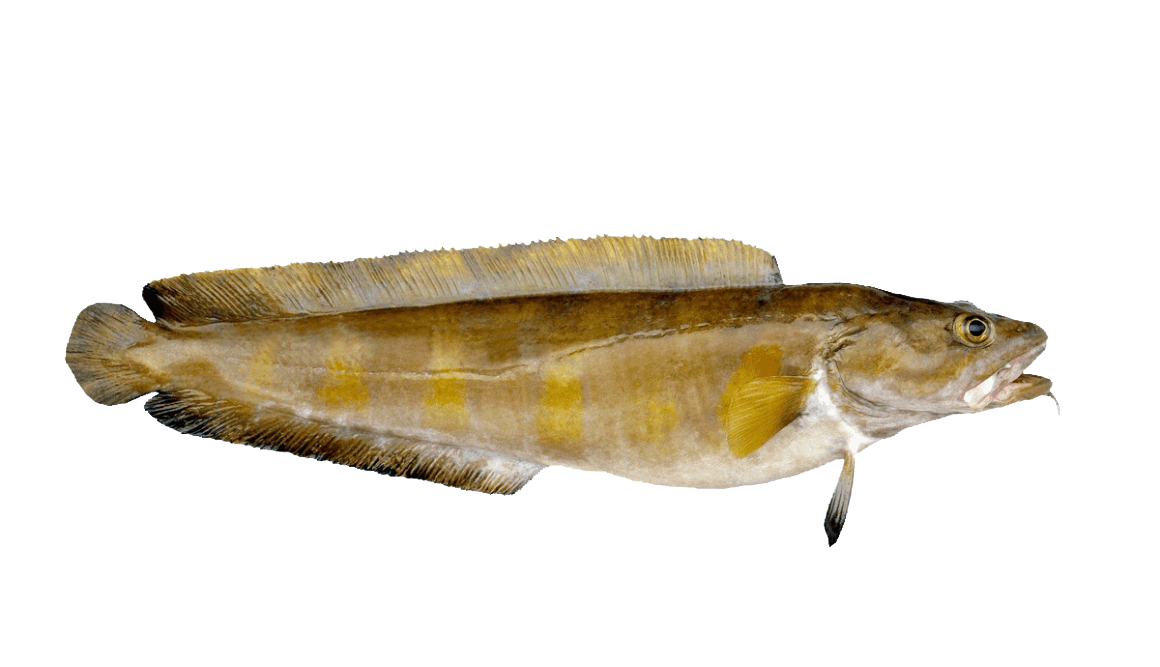Cusk

Species Details
Brosme Brosme
Lotidae
Gadiformes
Offshore, Deepwater
20 - 45 lbs.
36" - 47"
Cusk (Brosme brosme) Fish Description
Also known as brosmius, torsk, tusk, and torsk, the Cusk is a long-bodied fish resembling the cod.
The Cusk possesses a large mouth and a barbel on its chin. It has one dorsal and one anal fin, both long and connected only at the base up to the rounded tail. The Cusk’s fins have dark rims edged in white. Its body varies from yellowish or brownish to a color resembling slate; during the Cusk’s juvenile period, its color may be vertically barred with yellow. The Cusk's body is elongated, and its head is triangular and flattened. Its fine scales make it look slimy and even eel-like.
Cusks are slow growers and the maximum age of this species is believed to be around or greater than 14 years.
Cusk Diet and Size
Cusks are a bottom-dwelling species, which means they mostly feed on crustaceans, soft-bodied invertebrates, and mollusks. Cusks also enjoy benthic fishes like gurnard and flatfishes and even starfishes.
The Cusk may grow up to 36 to 42 inches long. Its maximum length is about 48 inches and its weight about 20 to 45 pounds. The Cusk sexually matures at the age of 3 or 4 years.
Interesting Facts About the Cusk
- Cusk meat is somewhat oilier, so it can be grilled and baked. It is also considered a fish that is good for frying and regarded as a substitute for cod (see Atlantic cod and Pacific cod).
- Cusks belong to the Lotidae family composed of cod-like fishes commonly known as lings.
- The Cusk’s large eyes help it detect its prey.
- Female Cusks can lay up to 2 million floating eggs at a time during spawning season. They are polygynous; meaning, each female only mates with a single male, even though male Cusks may mate with several female Cusks.
- It is a unique species of fish being the only member of the genus Brosme.
Cusk – Fishing Techniques
The most popular method of catching Cusk is using hook and line. Most of them are caught during winter and spring especially on the coastal shelves near the Canadian Maritimes and Maine. Cusks can also be captured using line trawls, especially on the New England coast. Most of them are just bycatch of fishing other more valuable species like cod and haddock. Some Cusks are also landed by longliners.
Cusks are weak swimmers and are sluggish so anglers may take advantage of that. Moreover, they can be harvested all-year round.
Cusk is an excellent food fish and marketed as fresh or frozen fillets.
Cusk Habitat and Distribution
Cusks are found along the bottom of the ocean in deep offshore waters on either side of the North Atlantic. They are normally found in waters deeper than 600 feet.
On the American coast, cusks are regularly found southward to Cape Cod and New Jersey. The greatest extent of its range covers most of the North Atlantic, from the waters around Iceland and the Norwegian Coast to the Mid Atlantic Ridge. They are also abundantly found in the Arctic, Atlantic, and Pacific Oceans.







